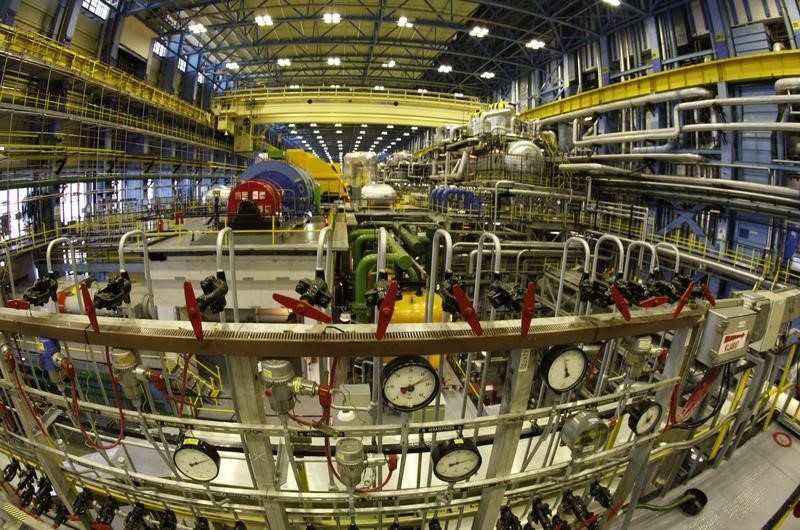* China to build 6 to 8 nuclear plants annually up to 2020
* Uranium prices to rise by more than half by 2018 -
analysts
* Global surplus of the metal to halve by 2020 - estimates
By Clara Denina
LONDON, Dec 28 (Reuters) - Uranium prices are expected to
outperform other commodities in 2016 and beyond as a global
climate change deal and growing demand from Asia bolster the
prospects of the nuclear industry.
The metal that powers nuclear reactors has been gradually
recovering from a sharp decline in the wake of Japan's Fukushima
disaster in 2011, and has gained this year as several other
commodities slumped due to oversupply and concerns about Chinese
economic growth and U.S. monetary tightening.
It is expected to climb further, according to analysts,
after governments forged a landmark agreement to reduce green
gas emissions at a global climate summit in Paris last month - a
move that supports nuclear power generation and in turn uranium.
Nuclear power stations currently provide around 11 percent
of the world's electricity but the share is likely to increase
as China and India expand their capabilities.
China - seeking to reduce its dependence on polluting coal -
plans to build six to eight nuclear power plants a year for the
next five years, and India aims to generate 25 percent of its
electricity from nuclear by 2050, up from 4 percent in 2013.
Meanwhile Japan is restarting four reactors, which may
accelerate the country's return to atomic energy.
"The China boom is only now happening and while 'nuclear'
might still be a toxic word, nuclear power generation is
recovering towards pre-Fukushima levels," said Macquarie analyst
Stefan Ljubisavljevic.
"It might not be popular, but it does provide the clean and
consistent base-load power generation that many nations are
seeking."
Prospects of higher demand and strategic stockpiling from
U.S. utilities sent spot prices UX-U3O8-SPT to an average of
$39 a pound in 2015, up 18 percent from $33 last year, making it
the best-performing metal of the year and one of the few
commodities to post a yearly increase.
Crude oil LCOc1 , the most traded commodity by far, lost 35
percent of its value this year, while benchmark base metal
copper CMCU3 fell 26 percent and gold XAU= dropped 9.4
percent. Cocoa CCH6 bucked the trend, with a 12-percent rise.
Both Bank of America-Merrill Lynch (BofA-ML) and BMO Capital
forecast uranium prices will rise to test $60 a pound by 2018.
URANIUM DEALS
Kazakhstan, the world's biggest uranium producer, has just
signed cooperation agreements with Chinese companies to build a
nuclear fuel plant in the central Asian country, while Canada's
Cameco CCO.TO , the world's largest listed uranium mining
company, signed a five-year deal in April to supply fuel to
Indian nuclear reactors.
BofA-ML analyst Oscar Cabrera said he expected uranium
prices to continue to advance after 2018, thanks to the
increasing demand from emerging markets China and India.
Uranium prices plunged after a major earthquake and tsunami
in Japan disabled the power supply of three Fukushima reactors,
causing a meltdown and the release of radioactive material in
March 2011. From around $60 before the disaster, they hit a
nine-year low of $28 in 2014.
Although the steep price decline resulted in mining cuts and
delays and cancellations of projects, stockpiles remain large.
Analysts' estimates of the global market surplus range from
20 million to 27 million pounds in 2015, which they say is
likely to fall to between 7.5 million and 10 million by 2020.
Around 150 million pounds of uranium are estimated to have
been consumed in 2015, according to data from the World Nuclear
Association.
Kazakhstan is the world's biggest uranium producer, followed
by Canada and Australia, while the United States is the biggest
consumer, followed by France and China.
BofA-ML forecasts consumption will rise to just below 200
million pounds by 2020.
"Uranium has proven to be a pretty good place to hide for
resource and energy-focused investors," said BMO Capital Markets
analyst Edward Sterck, adding: "I think it will continue."
(Editing by Veronica Brown and Pravin Char)
